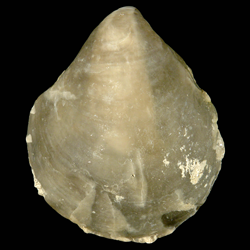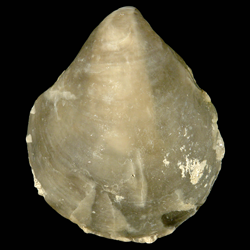
Anomiidae

Overview
Common name: Saddle oysters or jingle shells
Key morphological features: The Anomiidae range in size up to ~150mm. The shells are thin, translucent, inequivalve—with the left (upper) valve more inflated and the right (lower) valve flat and matching the contours of the substrate—compressed, and range in outline shape from circular to oval. The shell is composed of a combination of aragonite and calcite and coloration is variable, but can include bright oranges and yellows. The shell is anchored to the substrate by a thick byssus that passes through a characteristic subumbonal hole in the right valve and is calcified and permanently attached in most species. Exterior sculpture variable but usually weak, often reflecting features of the underlying substrate. Valve interiors are nacreous, and have a simple, uninterrupted pallial line. The interior shell margins are smooth. Species of Anomiidae are monomyarian, having only a posterocentrally positioned posterior adductor muscle as adults. Valve closure is accomplished with an enlarged posterior pedal retractor muscle that has attachments to the left valve and the calcified byssus. A result of this muscle arrangement is that the left valve has two muscle scars (the posterior pedal retractor muscle attachment and the posterior adductor muscle attachment) while the right valve has only one (the posterior adductor muscle attachment). The hinge plate is weak and edentate. Source: Mikkelsen, P.M., and Bieler, R. 2008. Seashells of Southern Florida: Bivalves. Princeton, New Jersey: Princeton University Press. 503 pp.
Geological range: Jurassic to Recent (Mikkelsen & Bieler, 2008).
Geographic distribution: A distributional map for modern Anomiidae may be accessed from OBIS. A distributional map for ancient Anomiidae may be accessed from the Paleobiology Database.
Diversity: There are 26 recognized living species of Anomiidae and 9 genera (WoRMS database, unvetted). The Paleobiology Database recognizes 20 fossil genera and 212 fossil species of Anomiidae (unvetted).
Paleoecology: The Anomiidae are almost exclusively sessile epibyssate, marine or estuarine, filter-feeding bivalves. The species Enigmonia aenigmatica (Holten, 1803) is an exception; it is mobile and crawls among mangroves and other intertidal environments. The Anomiidae can be found in temperate waters worldwide and inhabit a range of environments from the intertidal zone to the deep sea. Source: Mikkelsen and Bieler (2008).
Phylogenetic status: Unknown.

